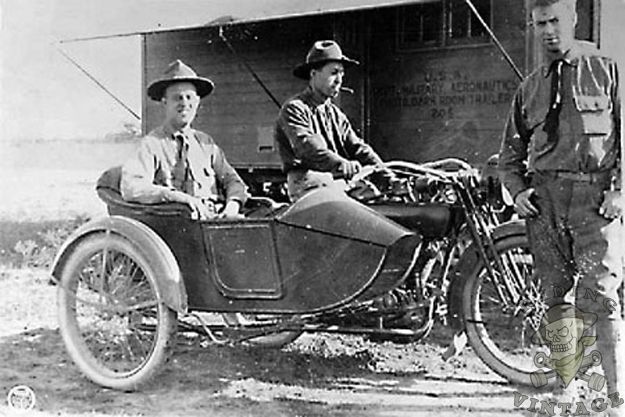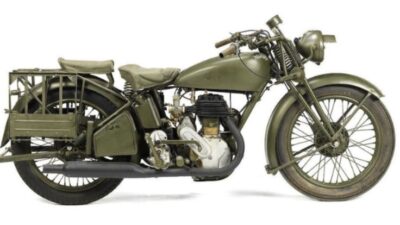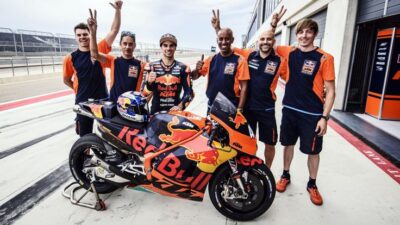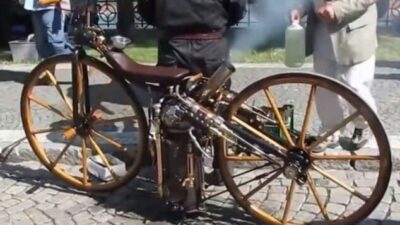When World War I erupted in 1914, motorcycles were still relatively new machines that looked more like powered bicycles than the sophisticated vehicles we know today. The war changed everything for these early motorcycles, transforming them from novelty items into essential military equipment.

The United States military ordered over 80,000 motorcycles during WWI, with companies like Harley-Davidson and Indian devoting massive portions of their production to the war effort. American manufacturers including Indian and Harley-Davidson supplied the bulk of these machines to Allied forces, while British companies like Triumph and Douglas also ramped up production significantly.
These military motorcycles served crucial roles as messenger vehicles, scout transport, and medical supply carriers across muddy battlefields where communication technology often failed. The war’s demands pushed motorcycle technology forward rapidly, but also devastated the industry afterward when military contracts ended and demand collapsed.
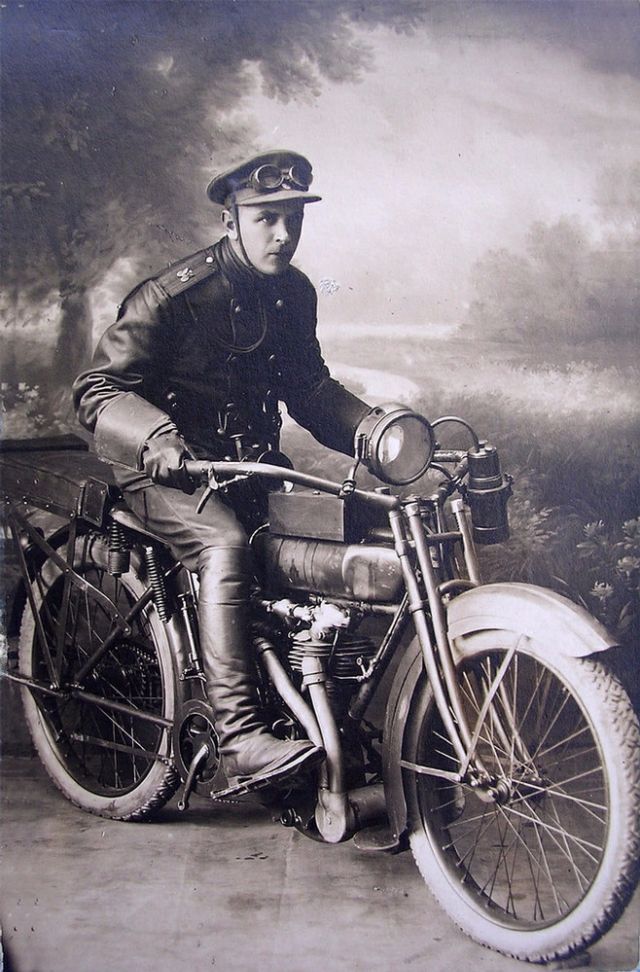
Key Takeaways
- Motorcycles evolved from powered bicycles to essential military equipment during World War I
- Major manufacturers devoted most of their production to military contracts, with over 80,000 motorcycles supplied to Allied forces
- The war accelerated motorcycle technology development but caused industry decline when military demand ended
The Emergence Of Motorcycles In Military Use

Military forces first adopted motorcycles in the early 1900s as they recognized the need for faster communication and reconnaissance. The technology proved essential during conflicts with Mexico and became widespread when World War I began in 1914.
Pre-War Military Motorcycling
Military leaders saw potential in motorcycles from their earliest development in the 1900s. The vehicles offered speed and mobility that horses could not match.
Early military motorcycles served primarily as messenger vehicles. Officers needed faster ways to send orders and receive reports from distant positions.
The U.S. military began testing motorcycles around 1913. They wanted alternatives to horse-mounted messengers who moved too slowly across long distances.
Key advantages of early military motorcycles:
- Speed up to 60 mph
- Ability to travel rough terrain
- Lower maintenance than horses
- Quick deployment capabilities
Indian and Harley-Davidson emerged as the main suppliers to American forces. Both companies modified their civilian models for military requirements.
Motorcycles in the 1914 Outbreak
When World War I started in 1914, armies immediately deployed motorcycles for various roles. The motorcycle’s military career began in World War I as a replacement for slower dispatch methods.
European forces used motorcycles extensively from the war’s beginning. German, British, and French armies all recognized their tactical value.
The motorcycles filled critical communication gaps. Radio technology remained limited, so physical message delivery was essential.
Military units mounted machine guns on motorcycle sidecars. This created mobile fighting units that could quickly attack and retreat.
Primary 1914 military motorcycle roles:
- Message dispatch
- Reconnaissance missions
- Medical evacuation
- Supply transport
- Mobile weapons platforms
The success in Europe convinced American military leaders to expand motorcycle use.
Influence of Pancho Villa and the Mexican Revolution
The pursuit of Pancho Villa during the Mexican Revolution proved motorcycles’ military value to American forces. Harley-Davidson motorcycles were used by the U.S. Army to hunt down Pancho Villa and his troops during this conflict.
Villa’s raiders moved quickly across difficult desert terrain. Traditional cavalry units struggled to keep pace with the Mexican forces.
General John J. Pershing’s expedition used motorcycles for reconnaissance and communication. The bikes performed well in harsh conditions that challenged other vehicles.
This experience taught American commanders important lessons about motorcycle tactics. They learned proper maintenance, rider training, and tactical deployment methods.
The Mexican border campaign directly influenced World War I preparations. Military planners incorporated motorcycles into their European war strategy based on Villa campaign results.
The success against Villa’s forces convinced the U.S. military to place large motorcycle orders from American manufacturers.
Key Roles Of Motorcycles On The Battlefield

Motorcycles served three critical functions during World War I combat operations. They enabled rapid message delivery across dangerous terrain, provided essential troop and supply transport, and formed the backbone of mobile machine gun units that could quickly respond to battlefield threats.
Dispatch Riders and Military Communications
Dispatch riders became the lifeline of military communications during World War I. These motorcycle-mounted soldiers carried vital messages between command posts, front-line units, and headquarters when telephone lines were cut by enemy fire.
The speed advantage was enormous. A motorcycle dispatch rider could cover distances in minutes that would take foot messengers hours to traverse. This rapid communication capability often meant the difference between successful coordinated attacks and costly military disasters.
Primary dispatch duties included:
- Delivering battle orders to front-line commanders
- Reporting enemy movements and positions
- Coordinating artillery strikes and infantry advances
- Maintaining contact between isolated units
Dispatch riders faced constant danger from enemy snipers, artillery bombardments, and treacherous road conditions. Many riders became skilled at navigating shell-torn battlefields and avoiding enemy detection through speed and stealth.
The reliability of motorcycles in harsh battlefield conditions made them superior to horses for messenger duties. Unlike animals, motorcycles didn’t tire, require feeding, or panic under artillery fire.
Battlefield Mobility and Transportation
Motorcycles revolutionized battlefield transportation by moving troops, supplies, and equipment rapidly across varied terrain. Military commanders quickly recognized their value for tasks requiring speed and maneuverability that larger vehicles couldn’t accomplish.
Transportation capabilities included:
- Moving small units to strategic positions
- Evacuating wounded soldiers from front lines
- Delivering ammunition and medical supplies
- Reconnaissance missions behind enemy lines
American motorcycle manufacturers like Indian and Harley-Davidson designed military models specifically for battlefield conditions. Indian produced nearly 50,000 motorcycles for the US Military, while Harley-Davidson delivered over 20,000 units.
The Indian PowerPlus featured an 18-horsepower engine capable of 60 mph speeds. Its three-speed transmission and front suspension made it ideal for rough terrain navigation. Harley-Davidson’s J series offered similar capabilities with a 15-horsepower F-head motor.
Motorcycle ambulances saved countless lives by quickly transporting wounded soldiers to medical stations. Stretchers adapted to sidecar frames could carry one or two injured troops much faster than traditional horse-drawn ambulances.
Armored and Sidecar-Mounted Machine Guns
Motor Machine Gun Service units transformed motorcycles into mobile weapons platforms. These specialized units mounted machine guns on sidecars, creating fast-moving fire support that could rapidly respond to battlefield threats.
Machine gun configurations included:
- Lewis guns mounted on rotating sidecar platforms
- Vickers machine guns with protective armor shields
- Hotchkiss guns for anti-aircraft duties
The tactical advantage was significant. Traditional machine gun positions were static and vulnerable to artillery strikes. Motorcycle-mounted guns could establish firing positions, engage targets, then quickly relocate before enemy forces could respond effectively.
Armored sidecars provided gunners with protection from small arms fire while maintaining mobility. Steel plates shielded the gunner and ammunition from enemy bullets and shrapnel fragments.
These mobile units proved especially effective in:
- Flanking enemy positions
- Providing covering fire for infantry advances
- Defending against cavalry charges
- Supporting reconnaissance patrols
The combination of firepower and mobility made motorcycle machine gun teams valuable assets for commanders seeking tactical flexibility on rapidly changing battlefields.
Notable Models And Manufacturers

Major motorcycle companies from America, Britain, and Germany produced thousands of bikes for military use. Indian built almost 50,000 motorcycles for the US Military, while Douglas produced over 70,000 motorcycles during the conflict.
British Triumph and Douglas Motorcycles
Douglas became the dominant British motorcycle producer during World War I. The company transformed from a small manufacturer into a major supplier for military forces.
Douglas produced over 70,000 motorcycles for military use. This massive production run made them one of the largest motorcycle suppliers of the war.
The Douglas bikes featured lightweight designs that worked well for dispatch riders. Their flat-twin engines provided reliable power for battlefield conditions.
British forces used Douglas motorcycles primarily for communication and reconnaissance missions. The bikes proved durable enough to handle rough terrain behind enemy lines.
Harley-Davidson and Indian Contributions
American manufacturers brought motorcycles from several US companies to help on the front lines. Indian and Harley-Davidson supplied the majority of American military motorcycles.
Indian devoted most of its production to the war effort, building almost 50,000 motorcycles. Their military model used the PowerPlus Big Twin engine.
The Indian PowerPlus featured a 61 cubic inch side valve motor that produced 18 horsepower. It could reach speeds of 60 mph and included both front and rear suspension.
Harley-Davidson delivered over 20,000 motorcycles to support the war. Their military model was based on the J series motorcycle.
The Harley-Davidson military bike used a 61 cubic inch F-head motor producing 15 horsepower. Both manufacturers replaced electric headlamps with simpler gas versions for military use.
German and Other International Models
German motorcycle manufacturers also contributed significantly to their military forces during World War I. Companies like BMW and NSU produced bikes for German troops.
German motorcycles emphasized durability and mechanical reliability. Many featured shaft drive systems instead of chain drives to reduce maintenance needs in field conditions.
Other European manufacturers from France, Italy, and Austria-Hungary supplied their respective armies. These bikes typically used smaller engines compared to American models but proved effective for dispatch work.
The harsh battlefield conditions challenged manufacturers to push technology forward. Many innovations from this period influenced modern motorcycle design.
Allied And Central Powers: Approaches To Military Motorcycles

The major powers of World War I developed distinct strategies for motorcycle warfare, with Britain pioneering specialized units, America supplying massive quantities of machines, and Germany facing significant operational constraints.
British Innovations and the Motor Machine Gun Service
Britain created the world’s first dedicated motorcycle combat unit in 1915. The Motor Machine Gun Service combined speed with firepower in ways never seen before.
British forces received 30,000 Model H bikes during World War I, with 20,000 going directly to UK units. These machines formed the backbone of mobile operations.
The Motor Machine Gun Service mounted Vickers machine guns on motorcycle sidecars. Each unit could move quickly between positions and deliver concentrated fire where needed most.
Key British motorcycle roles:
- Reconnaissance missions behind enemy lines
- Message delivery between command posts
- Rapid deployment of machine gun teams
- Medical evacuation using sidecar stretchers
British motorcycle units proved especially effective during the German Spring Offensive of 1918. They could respond to breakthrough attempts faster than horse-mounted cavalry or foot soldiers.
United States Military Motorcycle Deployment
American forces brought industrial-scale motorcycle production to the European battlefield. The United States Army began using motorcycles as early as 1913.
Harley-Davidson’s bike was chosen by General John J. Pershing for the 1916 pursuit of Pancho Villa in Mexico. This gave the company military credibility before the war.
When America entered the conflict in April 1917, two companies dominated military motorcycle supply:
| Company | Motorcycles Produced | Engine Type | Power Output |
|---|---|---|---|
| Indian | 50,000 | 61 cubic inch side valve | 18 horsepower |
| Harley-Davidson | 20,000 | 61 cubic inch F-head | 15 horsepower |
Indian devoted most of its production to the war effort. Their PowerPlus Big Twin could reach 60 mph reliably while carrying equipment.
American WWI motorcycles saw front-line action unlike their WWII successors. They were converted into ambulances and equipped with sidecar-mounted machine guns for “Motor Mobile Infantry” units.
German Moto-Tactics and Limitations
Germany faced severe resource shortages that limited motorcycle production throughout the war. Raw material restrictions forced German forces to rely heavily on captured Allied machines.
German motorcycle doctrine emphasized communication and coordination rather than direct combat roles. Their machines primarily carried messages between trenches and command positions.
German motorcycle limitations:
- Steel shortages reduced frame durability
- Rubber rationing created tire supply problems
- Fuel restrictions limited operational range
- Industrial capacity diverted to aircraft and artillery
Despite these constraints, German forces developed effective defensive tactics using motorcycles. Small units could quickly reinforce weak points along trench lines.
German motorcycle messengers became crucial during major offensives. They maintained communication when telephone lines were cut by artillery bombardment.
The Central Powers’ motorcycle shortage became more severe as the war progressed. By 1918, many German units operated primarily with captured British and American machines rather than domestically produced motorcycles.
Technological Advancements And Combat Adaptations

World War I pushed motorcycle manufacturers to develop more powerful engines, integrate weapons systems with sidecars, and establish comprehensive training programs for military mechanics. These innovations transformed basic civilian motorcycles into specialized military machines capable of handling the harsh realities of battlefield conditions.
Engine and Design Improvements
The demands of warfare forced manufacturers to enhance engine power and reliability significantly. Harley-Davidson’s Model J featured a 61-cubic-inch F-head motor producing 16 horsepower, while Indian’s PowerPlus Big Twin generated 18 horsepower from the same displacement.
Engineers strengthened frames to carry additional weight from weapons and supplies. They improved suspension systems to handle rough terrain that damaged civilian bikes.
Key Engine Specifications:
- Harley-Davidson Model J: 61 CI, 16 HP, 3-speed transmission
- Indian PowerPlus: 61 CI side valve, 18 HP
- Excelsior Model 19: 1000cc V-twin, 100 mph capability
Fuel capacity increased to extend operational range. The Model J carried 2.75 gallons compared to smaller civilian tanks.
Manufacturers tested bikes in deserts and mountains. The Excelsior Model 19 underwent extensive testing in harsh terrain, making it exceptionally rugged for battlefield use.
Sidecars and Weapon Integration
Military engineers developed specialized sidecars that transformed motorcycles into mobile weapon platforms. Harley-Davidson Model J motorcycles came equipped with sidecars, shields, and machine guns.
The British Motor Machine Gun Service used motorcycles with sidecar-mounted Vickers machine guns. Clyno motorcycles were specifically manufactured with Vickers machine gun attachments for this purpose.
Sidecar Applications:
- Machine gun platforms
- Medical stretchers for wounded evacuation
- Equipment and supply transport
- Communication equipment housing
Indian PowerPlus motorcycles featured sidecar-mounted machine guns and stretcher conversions for ambulance duty. These adaptations made single vehicles serve multiple battlefield roles.
Armored shields protected riders from small arms fire. Quick-release mechanisms allowed rapid weapon deployment when units reached their destinations.
Mechanic Training and Support
Military forces established comprehensive training programs for motorcycle maintenance and repair. Soldiers learned to service engines, replace parts, and perform field repairs under combat conditions.
Supply chains delivered spare parts to front-line units. Mechanics carried basic tools and common replacement components like spark plugs, belts, and oil.
Training covered engine troubleshooting, tire repair, and electrical system maintenance. Soldiers practiced repairs in simulated battlefield conditions with limited tools and time.
Essential Maintenance Skills:
- Engine timing adjustment
- Carburetor cleaning and tuning
- Chain and belt replacement
- Electrical system repair
Field workshops operated near combat zones to handle major repairs. These facilities rebuilt engines and fabricated replacement parts when factory components were unavailable.
The military standardized maintenance procedures across different motorcycle brands. This standardization helped mechanics work on various models with similar techniques and tools.
Legacy And Impact On Post-War Motorcycle Development

World War I fundamentally changed how militaries viewed motorcycles and shaped civilian motorcycle culture for decades. The war’s end brought surplus military bikes to civilian markets while establishing motorcycles as essential military equipment.
Influence on Military Doctrine
Military leaders recognized motorcycles as vital communication and reconnaissance tools after WWI. The transition of technology during the Great War proved motorcycles could handle harsh battlefield conditions.
Armies developed new tactics around motorcycle units. Fast-moving dispatch riders became standard in military communication plans. Scout units used motorcycles to gather intelligence behind enemy lines.
The success of motorcycle corps influenced military purchases between wars. Countries expanded their motorcycle fleets during the 1920s and 1930s. Training programs for military riders became permanent parts of army education.
Transition to Civilian Use
Thousands of surplus military motorcycles flooded civilian markets after 1918. Veterans familiar with bikes during service bought these affordable machines. This created a new generation of motorcycle riders across America and Europe.
Companies like Harley-Davidson and Indian shifted from military to civilian production. They kept many wartime improvements in their civilian models. Reliability features developed for combat proved popular with everyday riders.
The war experience changed how people viewed motorcycles. Before WWI, bikes were mostly for enthusiasts and racers. After the war, they became practical transportation for working people.
Commemoration and Historical Legacy
Veterans’ groups formed motorcycle clubs to maintain wartime friendships. These clubs organized rides and events celebrating their military service. Many clubs used military-style ranks and traditions.
Museums began collecting WWI motorcycles as historical artifacts. The bikes represented technological progress during the war years. Restoration projects preserved important military motorcycle models for future generations.
Annual commemorative rides honor WWI motorcycle units. Veterans’ descendants participate in memorial events using period-correct motorcycles. These activities keep the military motorcycle heritage alive in modern times.
Frequently Asked Questions

Motorcycles played crucial roles in World War I as communication tools and mobile platforms. The war drove rapid improvements in motorcycle design and production methods.
What were the primary roles of motorcycles in World War I?
Motorcycles served as fast communication vehicles to deliver messages between units. Telegraph lines were often cut by artillery fire, making motorcycles vital for British communication on the front lines.
Many units used motorcycles for scouting missions. Riders could move quickly across rough terrain to gather information about enemy positions.
Military motorcycles equipped with sidecar mounted machine guns created mobile weapons platforms. The British Army created the Motor Machine Gun Service in 1915 using these specialized vehicles.
Some motorcycles were converted into ambulances. These modified bikes could carry one or two wounded soldiers from battle areas to medical stations.
How did motorcycle technology advance due to World War I?
Early motorcycles in 1914 were basic bicycles with engines attached. Military needs pushed development of more battle-suitable designs during the war.
Engine power increased significantly during the conflict. American Indian motorcycles produced 18 horsepower compared to British Triumph bikes that only made 4 horsepower.
Transmission systems improved with three-speed hand shift systems becoming standard. Both front and rear suspension were added to handle rough battlefield conditions.
Technological advancements made during the Great War influenced modern bikes in later decades.
Which manufacturers produced motorcycles for the armed forces during World War I?
Indian and Harley-Davidson provided most American military motorcycles when the US entered the war in 1917. Indian built almost 50,000 motorcycles for the war effort.
Harley-Davidson delivered over 20,000 motorcycles to support the war. Excelsior, Henderson, and other US manufacturers also contributed smaller numbers.
British forces used Douglas and Triumph motorcycles extensively. Douglas produced over 70,000 motorcycles for military use during the conflict.
German forces relied on TWN and NSU motorcycles. TWN was actually the German branch of Triumph, operating under the name Triumph Werke Nürnberg.
What impact did World War I have on the evolution of military motorcycles?
The war established motorcycles as essential military equipment. Countries realized their value for communication, reconnaissance, and rapid transport of personnel and supplies.
Military requirements drove improvements in reliability and durability. Manufacturers had to build bikes that could operate in harsh conditions with minimal maintenance.
Mass production techniques developed during the war changed motorcycle manufacturing. Companies learned to produce thousands of identical machines quickly and efficiently.
After World War I, motorcycle use hit a decline as military demand disappeared. Many early manufacturers went out of business.
Can you list some notable models of motorcycles used in World War I?
The Indian PowerPlus Big Twin featured a 61 cubic inch engine producing 18 horsepower. This model could reach speeds of 60 mph reliably.
Harley-Davidson’s J series used a 61 cubic inch F-head motor with 15 horsepower output. It included a three-speed transmission and front suspension system.

British Triumph motorcycles produced only 4 horsepower but proved reliable for message delivery. Over 30,000 Triumph units were produced during the war.
Harley-Davidson J models were capable of speeds up to 60 miles per hour and came in both solo and sidecar configurations.
How were motorcycles integrated into military tactics and logistics during World War I?
American forces organized motorcycles into “Motor Mobile Infantry” units for front-line deployment. These units handled various specialized tasks.
Some motorcycles led convoys and provided general transportation behind battle lines. Others carried mounted machine guns for rapid attack missions.
The British Army recruited riders from motor clubs and racing leagues. These experienced civilians already knew how to operate motorcycles effectively.
Germans initially tried using motorcycles for cavalry charges to replace horses. This tactic failed because motorcycles could not handle uneven terrain as well as horses.
